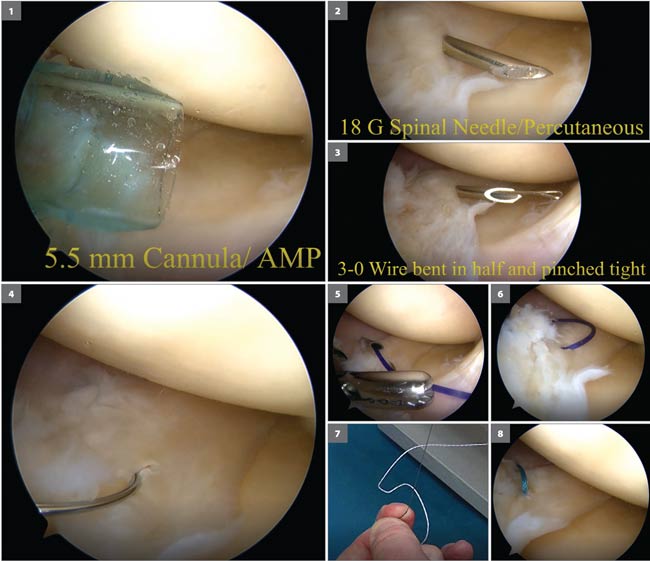Meniscus repair can be done inexpensively, relatively easily for certain cases, tear patterns
Meniscus repair is being done more frequently and applied to tear patterns that just a few years ago were thought to be irreparable. However, instrumentation may be expensive and repair techniques require advanced arthroscopic skills. In some cases of mid-third and anterior-third tears, repair can be done with little added instrumentation and by anyone who can do basic knee arthroscopy. I have successfully used this technique to treat mid-third and anterior-third meniscus tears for about 15 years. The procedure is easy to perform and is inexpensive because it uses equipment commonly found in most ORs. The technique allows the surgeon to do many of the more complicated steps outside the knee rather than requiring more technically difficult maneuvers inside the joint.
The procedure calls for a 5.5-mm cannula, 3-0 wire, #0 PDS synthetic absorbable monofilament suture (Ethicon), 2-0 Ethibond suture (Ethicon), an 18-gauge spinal needle and arthroscopic graspers. The 5.5-mm cannula is placed through the ipsilateral anterior portal and arthroscopic viewing is done through the contralateral anterior portal (Figure 1).
The spinal needle is passed through the body of meniscus (Figure 2). If the needle is passed through the meniscus multiple times, this can achieve trephination, which can add vascularity and enhance healing.
The type of 3-0 wire available in many ORs (Figure 3) is then used. It is pinched tightly so it easily goes down the 18-gauge spinal needle. It is possible then to reach through the cannula to grab the wire with a grasper and, while holding the wire, remove the spinal needle from the knee and deliver the wire out the cannula (Figure 4).

Figure 2. A spinal needle is seen penetrating the meniscus via a percutaneous medial approach.
Figure 3. A 3-0 wire that has been pinched tightly is passed down the 18-gauge needle.
Figure 4. The wire is grasped; the spinal needle is withdrawn and the wire is delivered out the cannula as shown.
Figure 5. A second 18-gauge needle has been introduced (vertical mattress) and a #0 synthetic absorbable monofilament suture has been passed down the needle and grasped.
Figure 6. The suture is shown after it was passed through the wire loop outside the cannula and the wire has been pulled back through the meniscus leaving a suture loop.
Figure 7. A loop has been created in the synthetic absorbable monofilament suture. The nonabsorbable suture has been passed through the loop and the loop has then been tensioned.
Figure 8. The synthetic absorbable monofilament suture has been pulled through the meniscus, pulling the nonabsorbable suture through, which replaces the synthetic absorbable monofilament suture with nonabsorbable material.
Source: Robert E. Hunter, MD
Vertical or horizontal mattress sutures
This process is then repeated with another spinal needle. This can be done using either a vertical or horizontal mattress pattern depending on the tear pattern. The second spinal needle is placed as desired and a #0 sterile synthetic absorbable monofilament suture is passed down the needle and into the joint where it is grasped through the cannula. Once grasped, the spinal needle is withdrawn from the knee to avoiding cutting the suture on the edge of the needle, and the suture is delivered out of the knee (Figure 5). The synthetic absorbable monofilament suture is passed through the wire loop outside the joint and the wire is pulled back down the cannula, through the meniscus and out the medial side of the knee. This results in a loop of suture through the meniscus and two free ends of suture exiting the medial knee, all of which is done without having to perform any technically difficult procedures within the knee (Figure 6). The technique can be applied to both the superior and inferior surfaces of the meniscus to maximize edge apposition, which can improve healing of the tissues.
It is the surgeon’s option to switch out the synthetic absorbable monofilament suture with an Ethibond or other nonabsorbable suture. At this point, make a small loop in one end of the synthetic absorbable monofilament suture and pass the 2-0 suture through this loop and pull the loop tight. Pull the free end of the synthetic absorbable monofilament suture and draw the 2-0 suture through the knee. This can be done easily in about 10 seconds (Figures 7 and 8).
This procedure can be repeated beginning posterior and working anterior and is applicable to tears in the mid-third and anterior-third of the meniscus. Once the sutures are passed, make one or more small 4-mm to 5-mm vertical incisions above the exit of the sutures on the medial or lateral side of the knee and sequentially withdraw pairs of sutures and tie them over the medial capsule. The repair also can be done without a medial incision, if desired. By using a probe or one side of a hemostat, one puncture wound created by the 18-gauge needle can be slightly enlarged. The probe is introduced through the puncture wound and the adjoining suture is retrieved in the subcutaneous fat and pulled out the same hole. The suture pair can then be tied through this puncture wound. (Figures 9 and 10).
Using this technique, outside-in meniscal repair for the middle and anterior-third of the meniscus can be completed quickly and effectively, which requires only standard arthroscopic skills to perform. Furthermore, it can be carried out without much expense to the patient, the health care provider or health care system

Figure 10. The anterior set of sutures pass through one puncture hole. Posterior sutures still exit through separate puncture holes.
- For more information:
- Robert E. Hunter, MD, can be reached at Heart of the Rockies Regional Medical Center, Orthopaedic Sports Medicine Center, 550 W. Highway 50, Salida, CO 81201; email: rhunter@hrrmc.net.
Disclosure: Hunter reports he receives consulting fees from Smith & Nephew and receives program support from DJO and Arthrex.







